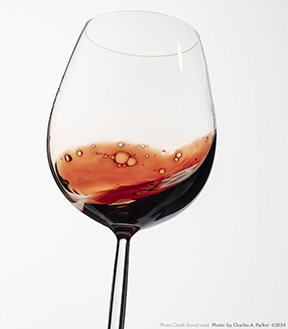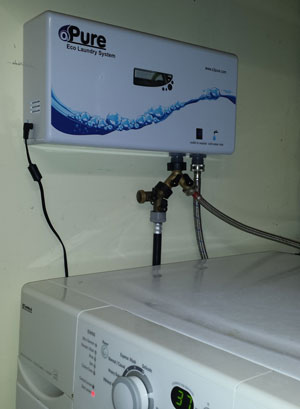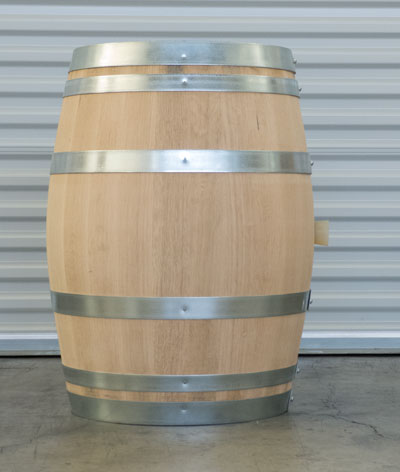Q I picked some Tempranillo that was a little past its prime. Chalk it up to not being able to coordinate with the vineyard owner in time and a heat spike that we had no control over. The skins themselves appeared to be oxidized and some of the fruit had some volatile acidity (VA) going on. I solved the VA problem with SO2. But the browning of the skins followed it into the wine. The pH came in at 3.68 (not too bad) and the Brix was at 25. If you don’t look at the color, the wine has a nice, light fruitiness typical of California Tempranillos. As a tasting experience it’s not too bad. But the optics leave a bit to be desired.
I’ve read all kinds of articles about browning in white wines (and things you might use to fix them) but nothing really addresses browning in reds. And this browning obviously came from the skins, not from oxidation of tannins due to aging (it’s 6–7 weeks old).
Any suggestions? I’m not averse to stripping it, so to speak, and then blending in some Syrah and even making more of a super Tuscan out of it, but how do I remove the browning?
Bob Warner
Fredericksburg, Texas

A There’s the old saw about the sow’s ear and the silk purse. It reminds me of my old adage of “never blend a loser,” which admonishes readers against blending bad wine into good. It improves the bad wine at the detriment to the whole blend. That’s too bad your grapes were suboptimal and you absolutely did the right thing adding the SO2 to try to combat the rot and potential VA issue.
Unfortunately, rot in both red wines and white wines, especially if Botrytis cinerea are present, can mean the presence of polyphenol oxidase (PPO) in the juice and must. PPO just loves to cause brown pigments and though most winemakers think of white wines when they think browning, this is because the colors in red wine usually cover up, outshine, and mask any brown pigments.
In this case, your browning issue was exacerbated by the fact that Tempranillo, especially if grown in a warm area, is what I would call a “lighter color” red like Pinot Noir. It often just doesn’t have the color density and optic power of a darker, denser wine like Petite Sirah or Petit Verdot. Additionally, extra SO2 can sometimes strip color. What you’ve got going here is a three-part punch: Lower initial color, bleaching by extra SO2, and PPO browning activity. I’m not surprised you’re less than happy with the results.
For future reference, here are some tips for dealing with rot in red grapes:
• Pick as cold as possible to reduce PPO activity as much as you can.
• Add at least 50 ppm SO2 upon crushing as the PPO enzyme requires oxygen to work and SO2 is an oxygen-scavenger.
• Try to maintain a carbon dioxide environment in your fermentation vessels before fermentation starts. Dry ice pellets do a great job of blanketing a grape bin before the grapes go in, for example (learn more about this and other uses of dry ice in the “Techniques” column in this issue beginning on page 46).
• Add extra tannin, like 300 ppm or so, of a commercial winemaking tannin before inoculation to act as oxygen scavengers and to “beef up” mouthfeel and color stability.
• Do not do a cold soak as more PPO can be released during this phase.
• Do not try a feral fermentation and be sure to use a fast-fermenting “bulletproof” yeast strain like Prise de Mousse.
• Keep maceration short to minimize the release of PPO.
• Try to exclude as much oxygen as possible during the aging process.
• Be aware that rot-affected wines may not age as long or as well as non-affected wines.
As to how to help your current batch, I would give fining agents a try. You could certainly try fining out some of the browning with polyvinylpolypyrrolidone (PVPP), and then see if you could mix in some darker varietals as long as you still like the aroma and flavor of the Tempranillo.
I say “never blend a loser,” but my longtime readers know I also say “do your bench trials.” If you find something that works, and especially something that you like, go for it! You’re in a great area for making amazing wines in Texas, I encourage you to keep trying! Unfortunately, sometimes we don’t have as much control of the condition of grapes when they come in as we’d like — especially as a home winemaker relying on others to grow and harvest your grapes — but we can use best practices to make the most out of what we have. Good luck!
Q In the June-July 2024 “Wine Wizard” column and elsewhere, there is repeated reference to paper chromatography as the only in-house way to monitor MLF, or else send a sample to a lab. I’ve been using the Accuvin MLF test strips for seven years with great success. Most of us just want to know if MLF is actually proceeding and if it is done — a qualitative measurement. These test strips are about $5 each and take four minutes to use. Why any home winemaker would not use these is beyond me. Vinmetrica also makes an MLF test, but it is cumbersome according to some of the people I have met that used them. BioAssay Systems makes the QuantiQuik test strips but from reading about them they are less convenient than the Accuvin kit.
Tom Shoup
Los Altos, California
A You are right, at WineMaker magazine we typically don’t want to advertise one product over another. That being said, we are always open to new advances and products that help our readers. I think this one is worth a mention, even if the results are only in a range and don’t (at least in my estimation) seem to be super-reliable in pinpointing a specific result. Will it tell you your MLF is going in the right direction? Like the Magic 8 Ball, answers point to “yes.”
I can understand why one might be tempted to try out the Accuvin Malic Acid Test Kit test strips (which, full disclosure, I haven’t), available on their website as well as other retailers. As a “Wine Wizard” reader, you’re probably familiar with my lamentations of (and my dissuasions thereof) the paper chromatography method, which involves multiple nasty chemicals and buckets of faff (as my British readers will interpret as “far too much trouble”). Similarly, sending never-ending samples to a lab can be cost- and convenience-prohibitive. The Accuvin tests seem to be an easy way to do on-or-off binary tests and can be quantitative enough to be seen as “is it moving/is it not.” Do be warned, some peer and online reviews have painted these tests as only right about 2⁄3 of the time and many mention that it’s tough to get within a 30 mg/L range of the right result.
The Accuvin Quick Tests test strips rely on color matching a test strip to an enclosed scale in the kit. It seems like an easy and simple method to use but does rely on timing and your ability to discern depths of color. The accuracy of the Accuvin Quick Test in the lower range of 30 mg/L can vary +/- 10 mg/L (33 percent).
Below is what was written in the Amazon listing of the product (go ahead and search it out for yourself — there are over 41 reviews) so . . . what I would do as a cautious Wine Wizard would be to test a finished wine with one of the Accuvin tests and also by sending a sample to a commercial lab. That way you’ll be able to really dial it in and see if your results from Accuvin are reliable and repeatable.
• “Test to control and monitor malic acid and completion of malolactic fermentation in wines.
• Quantitatively measures from 0–500 mg/L.
• Every kit comes with ten strips and ten samplers and requires no extra chemicals or instrumentation for accurate readings.
• Accuvin strips have a unique construction enabling the removal of pigments from red wines making them usable on any wine.
• No sample prep required, enabling you to get actionable results in a matter of minutes.”
Q We have a maple tree plantation in the family and we had the idea that we should experiment with maple sap to produce a wine. Rather than adding water to maple syrup, we reduced fresh sap to a potential alcohol of 10–12%. As there is very little if any acid present in the sap, the pH needed more acid. I added twice the recommended amount of acid blend, and then juiced several lemons. The acid was still too low, so I added the lemon rinds in a straining bag to the must. The result was a lemonade containing alcohol. I tried again without the lemons and only the amount of acid blend as stated on the bottle. The result is flavorless other than a hint of lemon from the acid blend and has very little body. I backsweetened with maple syrup attempting to add some flavor, but it quickly becomes too sweet yet still lacks flavor.
How can I retain or enhance natural flavors and increase body? We are really interested in trying to do a maple wine. I know it may sound weird, but it’s our local sugar source.
The Martins (Patrick, Martha and Bodhi the dog)
New Brunswick, Canada
A Maple sap is a great source of natural sugar and certainly qualifies as home winemaking material. What is less certain, as you’ve found out, is how much of those subtle maple aromas and flavors will stick around in a finished wine. I’m glad you’re experimenting with adding acid. Like you’ve discovered, maple syrup just doesn’t have enough natural acid on its own to create a balanced finished product. Acid blends will usually have a combination of malic and tartaric acids, which better mimic a grape’s natural acid profile and will help contribute to a better eventual mouthfeel and refreshing “zing.”
Lemon rinds, especially, as you’ve discovered, can contribute what is perhaps unwanted lemony aromas and flavors. Don’t forget that what makes a lemon “lemony” is all about that tiny, thin layer of yellow-colored zest on the very outside of the fruit. It’s after all why a martini “with a twist” can taste so citrusy with just a brush of lemon peel. The pith, or the white part underneath the yellow peel, is chock full of bitter and astringent compounds that you most likely don’t want to get into your finished wine. It’s undoubtedly contributing to those “lemonade” flavors that you describe not wanting.
To improve body and overall mouthfeel profile I suggest replacing about 1⁄4 to 1⁄3 of your sugar source (maple syrup) with a neutral white grape juice concentrate like Thompson Seedless or even Chardonnay. This will provide enhanced natural acid and body components and will also provide better yeast nutrition.
You might be interested in experimenting with some of the revolutionary liquid oak tannins that have hit the market in the last five years or so. Companies like AEB, Laffort, and Enartis (all can be found online) sell products that can enhance and amplify some of the lovely vanilla, caramel, and even maple flavors that oak aging brings to wine. Contact them to get some advice from a sales rep. I also think you might benefit from aging your maple wine on some kind of toasted oak product, again, to enhance and reinforce the maple, toasty, and baking spice notes that you are looking for.
If you’re looking to get more additional natural maple flavor into this project, might I suggest shopping for a little bottle of natural maple flavor online or at your local natural foods store? Because home winemakers aren’t bound by the same rules that commercial wineries are, you can add whatever finishing aromatic compound you’d like — flowers, fruit peel, vanilla, or maple extracts . . . let your palate and imagination be your guide. Add it when your wine is done fermenting (make sure it doesn’t contain any sugar — most do not) and in very small initial doses as some brands are quite strong.
Thinking even further outside the box, candy cap mushrooms provide a distinct maple flavor and aroma. You could make a tincture with them and add that to your fermented wine, or even loosely bag the dried mushrooms and let them age in the wine for a while.
Maple wine sounds like a great brunch wine with pancakes! My parents have close friends who have a maple stand in Canada and we’ve enjoyed their products on our pancakes for years. We admire the time, dedication, craft, and tradition it takes to produce maple products. I applaud you from afar in your efforts to create a maple sap wine!






